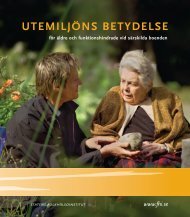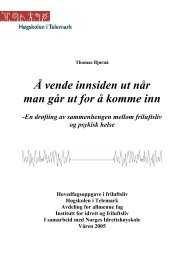Green Care: A Conceptual Framework - Frisk i naturen
Green Care: A Conceptual Framework - Frisk i naturen
Green Care: A Conceptual Framework - Frisk i naturen
You also want an ePaper? Increase the reach of your titles
YUMPU automatically turns print PDFs into web optimized ePapers that Google loves.
of St Dympna and stayed in a ‘therapeutic village’ where they were<br />
sympathetically cared for by the residents (and pilgrims were regularly<br />
weighed to demonstrate progress!) Bloor (1988) has described this as the<br />
first example of a ‘Therapeutic Community’.<br />
Oliver Sacks eloquently describes the history in his Foreword to Eugene<br />
Roosens and Lieve Van de Walle’s anthropological illustration of Geel’s<br />
current state:<br />
“In the seventh century, the daughter of an Irish king fled<br />
to Geel to avoid the incestuous embrace of her father, and<br />
he, in a murderous rage, had her beheaded. Well before the<br />
thirteenth century, she was worshipped as the patron saint<br />
of the mad, and her shrine soon attracted mentally ill people<br />
from all over Europe. Seven hundred years ago, the families<br />
of this little Flemish town opened their homes and their hearts<br />
to the mentally ill – and they have been doing so ever since.”<br />
(Roosens and Van de Walle, 2007, p. 9)<br />
This was a rural agricultural setting, and the main work activity for<br />
everybody was to work on the land. A range of structures and procedures<br />
were in place for taking care of these individuals in the context of local<br />
families and wider village life. The tradition of caring in this way still<br />
continues at the original town of Geel, 60km north-east of Brussels in<br />
modern-day Belgium (see Roosens, 1979, 2008).<br />
The literature contains a number of references to early observations<br />
of the mental benefits of agriculture. For example, Benjamin Rush, an<br />
American physician of the early nineteenth century, is often credited as<br />
being the ‘father’ of modern therapeutic horticulture through his apparent<br />
observations that working on the asylum farm was beneficial. The<br />
following passage appears in many modern texts:<br />
“It has been remarked, that the maniacs of the male sex in<br />
all hospitals, who assist in cutting wood, making fires, and<br />
digging in a garden, and the females who are employed in<br />
washing, ironing, and scrubbing floors, often recover, while<br />
persons, whose rank exempts them from performing such<br />
services, languish away their lives within the walls of the<br />
hospital.” (Rush, 1812, p. 226)<br />
14 <strong>Green</strong> <strong>Care</strong>: A <strong>Conceptual</strong> <strong>Framework</strong>















